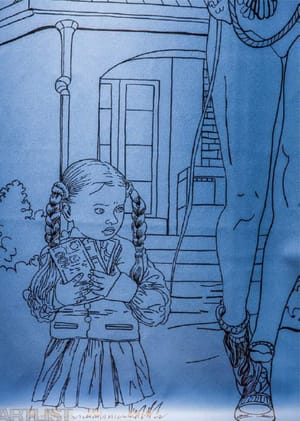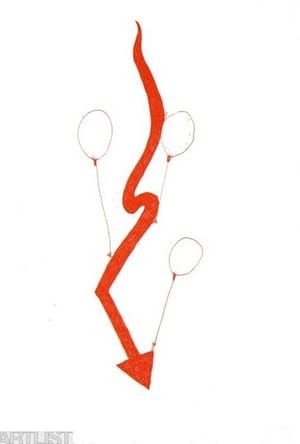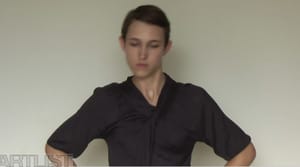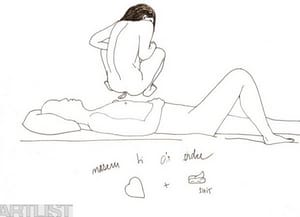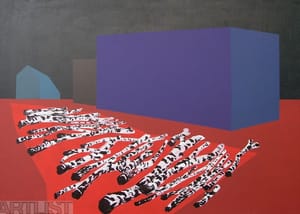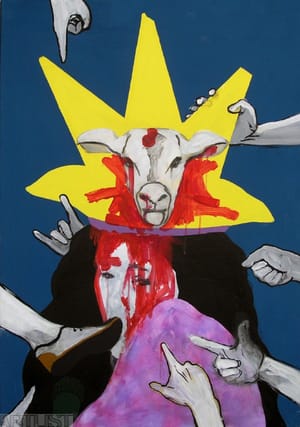- First Name
- Juliana
- Surname
- Höschlová
- Born
- 1987
- Birth place
- Praha
- Place of work
- Berlín, Praha
- Website
- www.julianahoschlova.com
- CSU Library
- ↳ Find in the catalogue
About artist
Juliana Höschlová’s work to date has occupied several aesthetic positions but stands on a joint base. Her intermedia work is based on a personal desire for interaction and a shift in the artistic construct in the direction of everyday human activities. Her projects therefore include happenings, social interventions and body art. However, her creative background is in drawing and painting, and these operate as visual meditations, illustrations that instantiate her internal life rather than external events. Drawing is the central medium that reconciles thoughts that are later translated into performances, videos and installations. However, a comparison of traditional and new media in Höschlová’s work crystallises into the same outcome, namely a directness and urgency of communication.
The cycle of videos entitled Holka od cirkusu / Girl from the Circus (2010) charts the specific movements of the artist’s body. Though the video comes across as very physical, this is simply by means of gestures of self-portrait that refer to family and individuality. Twisting the head, pulling the ears and stretching the neck muscles become symbols of human characteristics.
One aspect of Höschlová’s work could be called the architecture of social situations. Jazyk přátelství / Language of Friendship (2011), her degree work in the studio led by Vladimír Skrepl, staged a readymade situation of a karaoke bar within a gallery space. An intimate environment arose that was separated from the artistic context and served mainly for social interaction. However, videos of groups of people who sang along also became an output. The same could almost be said of the performance Situation 35 (2013), the difference being that manipulation and pressure enter into the entire process. A list of 270 songs was placed in front of the Pavilion Gallery and viewers entered one-by-one into the space, where the artist sang them a song of their choice in the style of karaoke. The other arrivals were outside and were able to follow what was going on inside. Although the entire event was an artistic construct, the artist herself was place in the role of someone who grants the wishes of others within the system as configured.
Voyeurism and an interrogation of the boundaries between voluntary and compulsory activities is intensified in the performance Tančí jak pískáš / She Dances When You Whistle (2012). Here Höschlová danced to songs requested until exhausted. She was enclosed in a room behind a curtain, where she was photographed by a camera that transmitted the recording to a television being watched by visitors. The attempt to break down the distance between performer and viewer in Language of Friendship is transformed here into a cold system separated by the two sides of an imaginary wall. Höschlová again created a relational reality whose rules she was voluntarily subject to.
A joint project whose ambitions surpass the narrow collective of people and territorial boundaries is Políčko / Square (2011), which dates back to Höschlová’s study trip to Taiwan. This complex work, which includes websites, a series of videos, lectures and books, is concerned with contemporary Taiwanese society. Its ambitions go beyond the creative and it has an educational, research character. Using interviews with artists and curators, the artist infiltrates the mentality of Taiwanese society and the conflict between traditional values and those being imported by the new globalised world. She focuses on the relationship to contemporary art and this leads to questions of politics and the functioning of institutions.
The antithesis to Square, which maintains a balance between visual art and sociological survey, is the much more traditional Geniální umělec / Genius Artist of 2013. This is a life-sized self-portrait in oils. Only the title mocks the traditional artistic form. Even though at first sight performance and oil painting might appear to be media based on different principles, the subjective interrogation contained in Girl from the Circus and Genius Artst lends them a similar conceptual basis. More knowingly critical is the theme of a site-specific installation aptly called Úlisnost / Glibness (2015). Here Höschlová comments in illustrative style on the operations of the consumer world. Drawings mock the world of advertising, which garishly preys on human awareness. The atmosphere of a monumental drawing is supported by the material used for the background. This is artificial leather symbolically endorsing the frequent principle of commercials, namely a pleasing surface and lack of depth.
The video Na Friedricha / To Frederick (2014) also draws mainly on mainstream imagery. This short film expands on the traditional romantic motif of the lonely person in the countryside. However, if its inspiration, the picture Wanderer Above the Sea of Fog by Caspar David Friedrich portrays a man lost in thought, Höschlová’s reinterpretation comprises the emotionally charged moments of the film characters of women. Fragments are interspersed full of sadness, melancholy, hope and futility, though their rough transition emphasises the fiction of film narrative. This work investigates a certain film archetype and is part of the current of media archaeology, which is a highly topical domain for the current generation of artists.
- Author of the annotation
- František Fekete
- Published
- 2015
CV
2012
The University of Jan Evangelista Usti nad Labem, Faculty of Art and Design, Visual Communication, Ph.D studies
2006–2011
Academy of Fine Arts in Prague, Vladimir Skrepla
2009–2010
Taipei National University of the Arts / Graduate Intitute of Arts and Technology, Taipei, Taiwan
2008
FAMU Prague, studio sound Iva Blaha
2007
Studio visiting professor, Anton Black, Prague
2002–2006
Secondary School of Applied Arts in Prague
awards:
2010
1st place of prize National Gallery in Prague Ng 333
Exhibitions
- Solo exhibitions
-
2015
Úlisnost, galerie Altán Klamovka, Praha
2014
Where is Jesus?, Page Five, Praha
2013
Geniální umělec, galerie Buňka, Ústí nad Labem
2010
To be ontinued, galerie Armaturka, Ústí nad Labem
2009
+ and -, spolu s Šárkou Teleckou, 8 1/2 Gallery, Taipei, Taiwan
2008
Skryté místo, spolu s Alicí Hilmarovou, GAVU, Praha
- Group exhibitions not included in ARTLIST.
-
2015
Hlad, Festival Performance, Praha
2014
Markýz z Laverne, Povaleč festival, Povaleč
2014
Lustr festival, Art Salon S galerie Microna, Praha
2011
Místo, kam nepatřím, Trafačka, Praha
2011
Diplomanti AVU 2011, Karlin Halls, Praha
2011
Za hřbety knih, které jsem nečetla, Letohrádek Hvězda, Praha
2010
Finalisté ceny Ng 333, Národní galerie, Praha
2010
How Miao, VT artsalon, Taipei, Taiwan
2009
cena Arskontakt, výstavní síň Chrudim
2008
I.D.E.G.O., GAVU, Praha
2007
Žvýkačka Ambra, GAVU, Praha
2007
Chebské dvorky, Cheb

